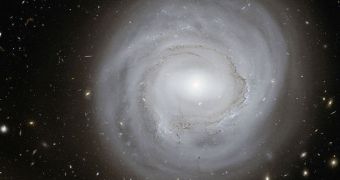The northern constellation of Coma Berenices is home to one of the closest and brightest galaxy clusters astronomers are familiar with, namely the Abell 1656, also known as the Coma Galaxy Cluster (CGC). This formation holds up to 1,000 galaxies, most of them elliptical. However, one of them, which happens to be a spiral, exhibits some unusual properties, and represents a first, as far as readings go, for the Hubble control team. The weird galaxy is located approximately 320 million light-years away from the Earth.
Due to the fact that CGC holds so many such aggregates, it's inevitable that the interactions between them be far greater in number and intensity than those taking place between galaxies populating less dense regions of the Universe, outside major clusters. Many mergers that happen in large clusters force most gas-rich spirals to turn into ellipticals, as a constant rearranging takes its toll on their layout.
One galaxy in particular, dubbed NGC 4921, was only recently identified by the Hubble Space Telescope, while it was conducting a survey of the entire area. This galaxy, spiral-shaped, is what astronomers call an “anemic.” It shows very little signs of activity in its central area, which is very rare, considering that massive star-forming processes are usually the trademark of spirals and their glowing arms. But this one is different, in that it most likely lacks the gas necessary to start actively-forming many new stars.
A few bright young blue celestial bodies are all that accompany a swirl of dust situated near the galaxy's core. Its arms are unusually smooth for a spiral, and its overall aspect resembles that of a jellyfish left stranded in the water. What's even weirder is that galaxies around CGC have also various shapes and sizes, but that's natural, considering that they are so old and they belong to a period when differentiation between spirals and ellipticals was not yet made clear.
The Wide Field Channel of the Advanced Camera for Surveys aboard Hubble has been used to snap the new picture of NGC 4921, which is actually made of two distinct photographs, one taken in a yellow filter, and one in a near-infrared wavelength. For the yellow picture (made up of 50 different stitches), Hubble was programed with an exposure time of 17 hours, while the other picture (made up of just 30 exposures) only took 10 hours to complete.

 14 DAY TRIAL //
14 DAY TRIAL //